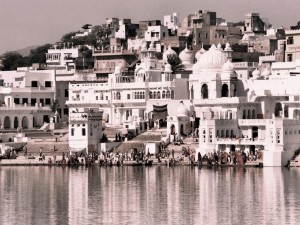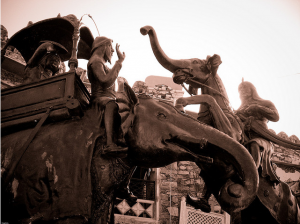 Rajasthan’s long history is as varied and colorful as its culture and people. Since the pre-historic times, the state has played an important role in the region. Archaeological excavations point that Harappan culture flourished in parts of Rajasthan as early as 1000 BC. The state was also a seat of Paleolithic settlements, according to the paintings from the period in some areas. At Dundhmer, the modern day
Rajasthan’s long history is as varied and colorful as its culture and people. Since the pre-historic times, the state has played an important role in the region. Archaeological excavations point that Harappan culture flourished in parts of Rajasthan as early as 1000 BC. The state was also a seat of Paleolithic settlements, according to the paintings from the period in some areas. At Dundhmer, the modern day
Dundhar, the first Aryan settlement has been discovered. Ancient Hindu scriptures make references to the holy city of Pushkar.
The land of valour and glory, Rajasthan has been the stage for many historic battles and has stood witness to several dynasties and empires, from Magadha, Kushanas, Guptas or Mauryas of ancient India to slave dynasties, Mughals or the British in the more recent history.The formation and development of Rajasthan is attributed to several tribes like the Rajputs, Jats, Bhils, Ahirs, Nath, Gujars, and Meenas who are the prominent inhabitants of the state. Out of these, Rajputs have played a dominant role in the history of the state.
The Age of the Rajputs
According to the Hindu mythology, the Rajputs are Kshatriyas, or the warrior class of Vedic India. The rajuts rose to the peak of their power around 6thto 12th century. The earliest Rajputs, who ruled Rajasthan in 640 AD, were the Gurjar Pratiharas. By the end of 7th century, Rajputs had consolidated themselves as a formidable force and the region was in their firm grip. This paved way for extensive development of Rajasthan. There were several Rajput clans, like the Sisodias, Rathores, Chauhans, Kachhwahas and Bhatis, who empowered Rajasthan considerably, economically, socially and militarily. The Rajputs also contributed to the architectural heritage of the state, constructing some of the finest forts, palaces and monuments in the region.
The 12th century witnessed invasions by Islamic invaders like Mohammed Ghori. In the battle of Tarain, Ghori was killed by Rajput ruler Prithviraj Chauhan, despite defeating Chauhan in battle. Even the Mughals recognized the Rajput valor and fostered alliances with them, despite defeating them in battles. Mughal emperor Akbar himself married Rajput princess Jodha Bai, the daughter of the Maharaja of Amber. Under his rule, Rajput princes held high offices and he maintained very cordial relations with Rajputs. Maharana Pratap was a legendary Hindu ruler of Mewar who offered a daunting challenge to Akbar’s supremacy. In popular Indian culture, Pratap is considered to exemplify the qualities like bravery and chivalry to which Rajputs aspire.
When the influence of the Mughals started waning, Rajputs reasserted their power and dominance but that was to be short-lived. The Pindaris and the Marathas soon attacked the Rajputs of Rajasthan. Later, when India came under British rule, Rajputs maintained local autonomy while agreeing to British sovereignty. When the country got independence in 1947, the erstwhile Rajput kingdoms and British provinces were merged to form the state of Rajasthan as it stands in its present form.

